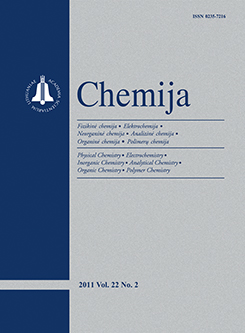Chemija / Chemistry
WHAT?
 ISSN 0235-7216 ISSN 2424-4538 (online) |
2013 m. Nr. 1 Use of the BCR sequential extraction procedure for element fractionation in activated sludge from the pulp and paper mill
In this study, the elements in the activated sludge were fractionated between acid-soluble (CH3COOH; BCR1), reducible (NH2OH-HCl; BCR2) and oxidisable (H2O2 + CH3COONH4; BCR3) fractions. Only the extractable concentrations of Mn (523 mg kg–1; d. w.), Ni (5.1 mg kg–1; d. w.), S (1 650 mg kg–1; d. w.) and Ti (1.3 mg kg–1; d. w.) in the BCR1 fraction were higher than those in the BCR2 fraction. The extractable concentration of Mn in the BCR1 fraction was also higher than that (160 mg kg–1; d. w.) in the BCR2 fraction and that (135 mg kg–1; d. w.) in the BCR3 fraction. However, if we disregard elements whose concentrations were lower than the detection limits, as well as Ba and Mn, the extractable concentrations of other element in the BCR3 fraction were higher than those in the BCR1 and BCR2 fractions. The recovery values (R% values), which are the ratio of sum of BCR sequential extraction procedure to the total digestion using USEPA method 3051A, varied between 81.6% (Ni) and 96.4% (V). Due to the high R% values for certain elements we would like to point out that caution must always be exercised when activated sludge is utilized and the existing legislation must always be applied. Keywords: BCR, extraction, pulp and paper mill, wastewater sludge, waste |
Issues:
2017 - Vol.28 No. 1, No. 2, No. 3, No. 4 2016 - Vol.27 No. 1, No. 2, No. 3, No. 4 2015 - Vol.26 No. 1, No. 2, No. 3, No. 4 2014 - Vol.25 No. 1, No. 2, No. 3, No. 4 2013 - Vol.24 No. 1, No. 2, No. 3, No. 4 2012 - Vol.23 No. 1, No. 2, No. 3, No. 4 2011 - Vol.22 No. 1, No. 2, No. 3, No. 4 2010 - Vol.21 No. 1, No. 2-4 2009 - Vol.20 No. 1, No. 2, No. 3, No. 4 2008 - Vol.19 No. 1, No. 2, No. 3-4 2007 - Vol.18 No. 1, No. 2, No. 3, No. 4 2006 - Vol.17 No. 1, No. 2-3, No. 4 2005 - Vol.16 No. 1, No. 2, No. 3-4 2004 - Vol.15 No. 1, No. 2, No. 3, No. 4 2003 - Vol.14 No. 1, No. 2, No. 3, No. 4 2002 - Vol.13 No. 1, No. 2, No. 3, No. 4 2001 - Vol.12 No. 1, No. 2, No. 3, No. 4 |